The following report, prepared in collaboration between Alea Research and Castle Capital, is a deep dive into the current state of Arbitrum, delving into ongoing technological developments, highlighting upcoming catalysts, and anticipating what the future adoption rate looks like.
Key Takeaways
- Arbitrum remains the most dominant and widely adopted L2 on Ethereum, with approximately half of the market share and over 500 protocols.
- Arbitrum commands a 50% L2 market share with a TVL of $3 billion, ranking as the fourth-largest blockchain network.
- DeFi and derivatives remain the most dominant market sectors on the chain, attracting projects working on a broad range of instruments, such as perps, options, yield trading, and structured products.
- Post-airdrop, $ARB price showed stability around $1, fluctuating 10-20%, with an all-time high of $2.40, achieved in January 2024.
- Arbitrum has a token unlock scheduled for March 16, 2024, when 1.11 billion $ARB tokens (87.5% of the current circulating supply) will enter circulation.
- There are both shared and unique catalysts on the horizon that could further enhance the value proposition backing the $ARB token. On the one hand, EIP-4844 will significantly reduce data availability costs for rollups. On the other hand, Arbitrum Orbits and the Stylus upgrade will specifically contribute towards the growth of the Arbitrum ecosystem.
- The DAO continues to generate significant revenue from sequencer profits (~$16.6M in 2023) and, even though most of this liquidity remains unutilized, there are ongoing initiatives aimed towards ecosystem growth, such as STIP and LTIP.
Introduction
Arbitrum’s prominence in the L2 landscape is evident, with a substantial market share of over 55%, and ranking fourth in TVL across all blockchains. With more than 500 protocols deployed on the chain, Arbitrum also leads in critical metrics such as transaction volume and Ethereum gas consumption.
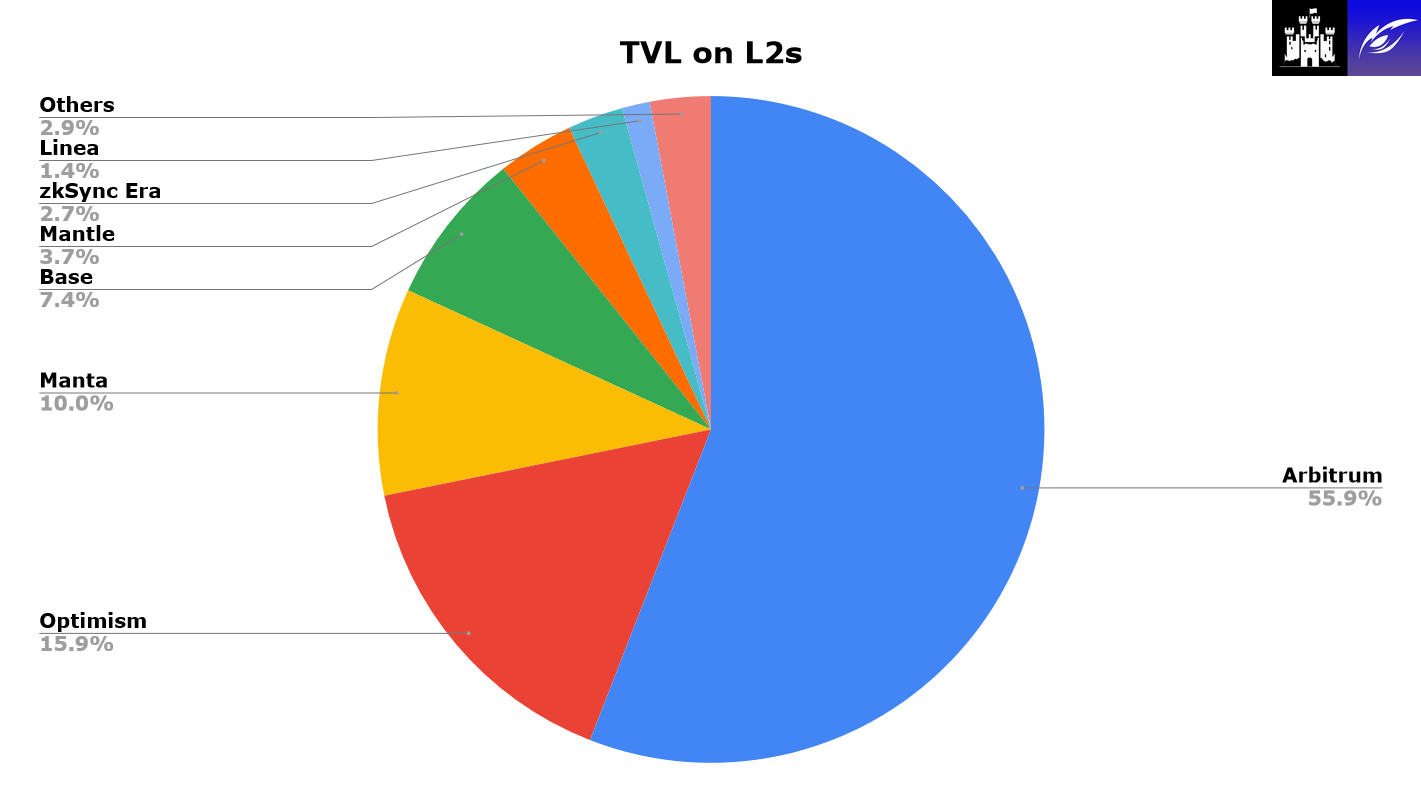 |
Source: DeFiLlama
The year 2023 marked a pivotal moment for Arbitrum. The much-anticipated $ARB airdrop unfolded, generously rewarding over 500,000 wallets with an astounding sum of more than 1 billion $ARB tokens.
This strategic move not only solidified Arbitrum’s market presence but also propelled its TVL from a commendable $1 billion at the start of 2023 to approximately $2.4 billion, firmly establishing it as the leading rollup in terms of TVL and capturing a significant portion of the L2 market share.
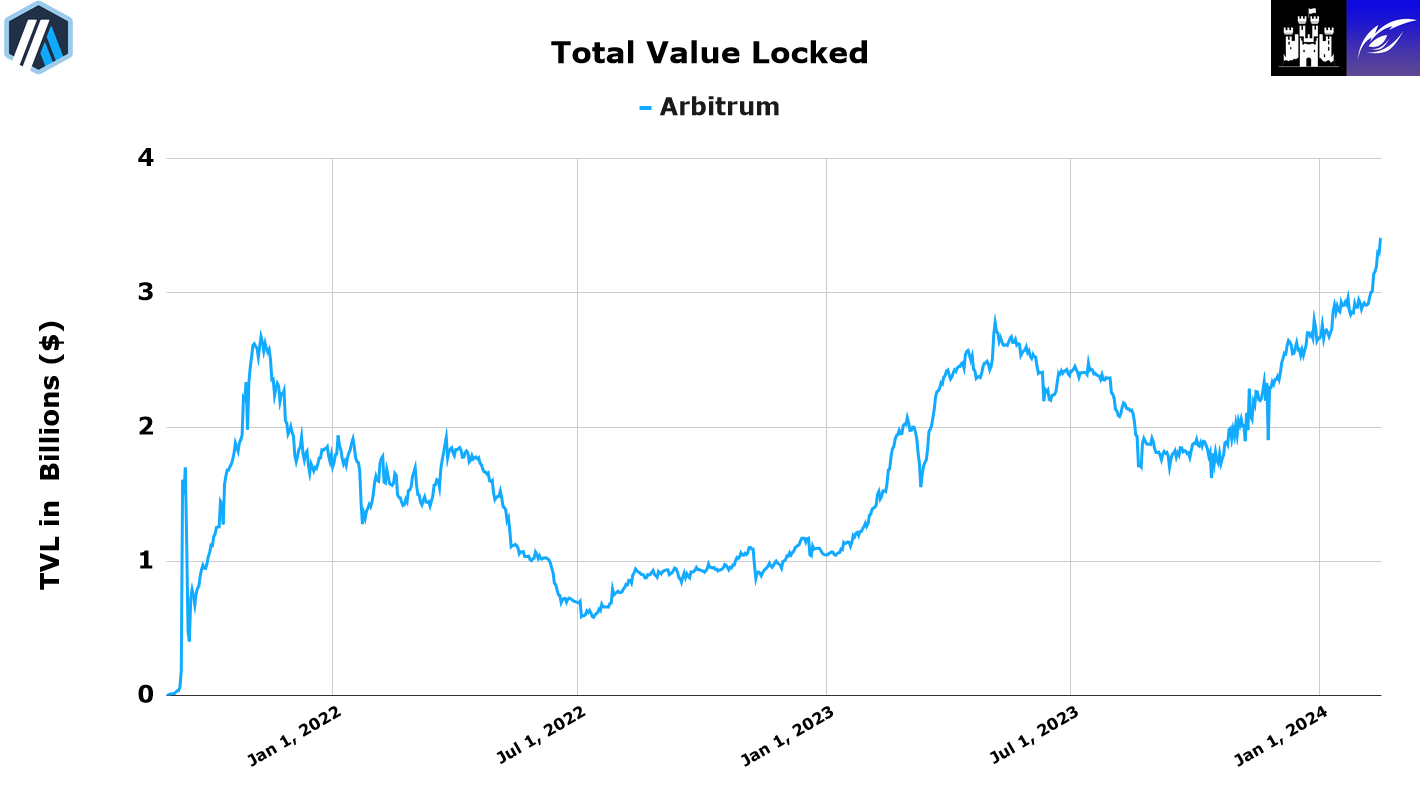 |
Source: DeFiLlama
Looking ahead, the upcoming Dencun upgrade and EIP-4844 present a noteworthy catalyst to improve Arbitrum’s economic model, reducing costs by almost 90%. Positioned as the most adopted rollup, Arbitrum’s strategic advantage is further bolstered by the anticipation of additional specific upgrades, including the introduction of Arbitrum Stylus and the launch of new Arbitrum Orbits.
EIP-4844
As we know, using the Ethereum mainnet cannot be decoupled from rising transaction fees, hence the great urgency to drive an ecosystem-wide adoption of rollup-based L2s. However, rollups need to post transaction data to Ethereum for settlement and Data Availability, with the latter making up most of the transaction costs.
EIP-4844, expected to be released to production on March 13th, commonly referred to as Proto-danksharding, is a massively anticipated catalyst not only for Arbitrum but for all Ethereum L2s and is due to come into force with the Dencun upgrade of Ethereum as a larger part of the Ethereum roadmap.

When the EIP-4844 upgrade goes live, it will introduce a new concept called “blobs” for posting data, promising substantial cost reductions that could see Data Availability costs fall by up to 90%. However, the exact amount of savings is uncertain.

Blobs are a much cheaper method for rollups to verify posted data, dramatically reducing the cost burden on users. This new transaction type, a “blob-carrying transaction”, is similar to a regular transaction but also carries “blobs” which are extra pieces of data added onto the transaction structure. Blobs are very large in storage capacity and come at a fraction of the cost of comparable amounts of calldata.
Image: Ethereum Post EIP-4844

Blobs are not permanent; they are stored on Ethereum temporarily, for a period typically ranging from 1 to 3 months, after which they are deleted. This period ensures sufficient duration for transaction data verification without imposing an indefinite storage obligation on the network.
Comparable to blockspace on the Ethereum mainnet, blobspace is the designated area within blocks where blobs are posted. This creates a new market dynamic, with blobs including a field for dynamic fee adjustments.
As a result, during high-traffic periods on the Ethereum mainnet, the blob market is expected to remain relatively unaffected. This stability ensures that transaction inclusion fees within blobs remain manageable and, as a result, the fees users pay for transactions on rollups like Arbitrum will not be as high as they would be in a pre-EIP 4844 world.
Image: Cost vs. Blob Size

A good rollup aims to keep costs low and post data quickly for its users. However, these goals conflict. Posting data cheaply means waiting to fill up a data block (blob) before posting it. However, posting quickly often means using partially filled blobs, which costs more because you pay for the whole blob regardless of how much you use.
The strategy depends on the cost of blobs. If blobs are expensive, it’s better to wait and post full blobs. If blobs are cheap, you can afford to post more frequently, even if the blobs aren’t fully used. The cheaper the blobs, the more you can post, and the less you need to fill them. Consequently, blob usage moves inversely to blob price: fewer blobs are used when the price is high, and more blobs are used when the price is low (blobs may also be less full).
After the retention period, blobs are slated for deletion, ensuring Ethereum isn’t perpetually burdened with excessive data. This way, it is possible to ensure that L2 transaction data is available to all relevant nodes for a limited period, fulfilling the specific data availability requirements of rollups like Arbitrum.
Learn more about EIP-4844 in Castle Capital’s: Deep-Dive into Data Availability report!
Stylus
Stylus is an upgrade to Arbitrum Nitro, the underlying tech stack powering Arbitrum One, Arbitrum Nova, and Orbit chains. The major improvement is the addition of a second virtual machine where EVM contracts continue to behave exactly as they would on Ethereum. As an upgraded version of Nitro, Stylus functions as both node software and a fraud-proof system for Arbitrum.
Table: Benefits of Stylus on Each Part of the Tech Stack
The standout characteristic of Stylus is the extension of Arbitrum’s EVM capabilities to support other programming languages like Rust or C++. This is achieved by enabling the processing of any programming language that can be compiled down to WASM, while the EVM contracts remain unchanged.
The main difference is that this second virtual machine executes WASM rather than EVM bytecode. Programmers have been making WASM better for decades, especially for Rust and C. Additionally, WASM itself runs faster than the standard way of doing things on the EVM using Solidity.
For reference, WASM can make contracts run about 10 times faster than using Solidity. In fact, WASM is a standard for many companies like Google, Apple, and Microsoft, and web browsers use it to generate pages. Therefore, it needs to be fast, and thanks to its industry adoption, the runtimes that use WASM execution are much faster than those used in the traditional EVM.
Stylus facilitates a more extensive ecosystem of developers by accommodating dApps initially developed in Rust for other ecosystems, enabling a seamless transition to Arbitrum without converting to Solidity.
According to the latest Statista report, which surveyed 87,585 software developers, only 1.33% of respondents used Solidity – which makes sense considering it is only used in blockchain and EVM environments. By comparison, 19.34% and 22.42% of respondents used C and C++, respectively, and 13.05% used Rust. Stylus makes it very simple for these developers to use technologies they’re already familiar with, not forcing them to learn a new language like Solidity and Vyper.
Because of WASM compatibility, Nitro adopts all the benefits that come with a WASM runtime, taking advantage of the efficiency of Rust and C programs, as well as onboarding developers who have been using those languages for decades.
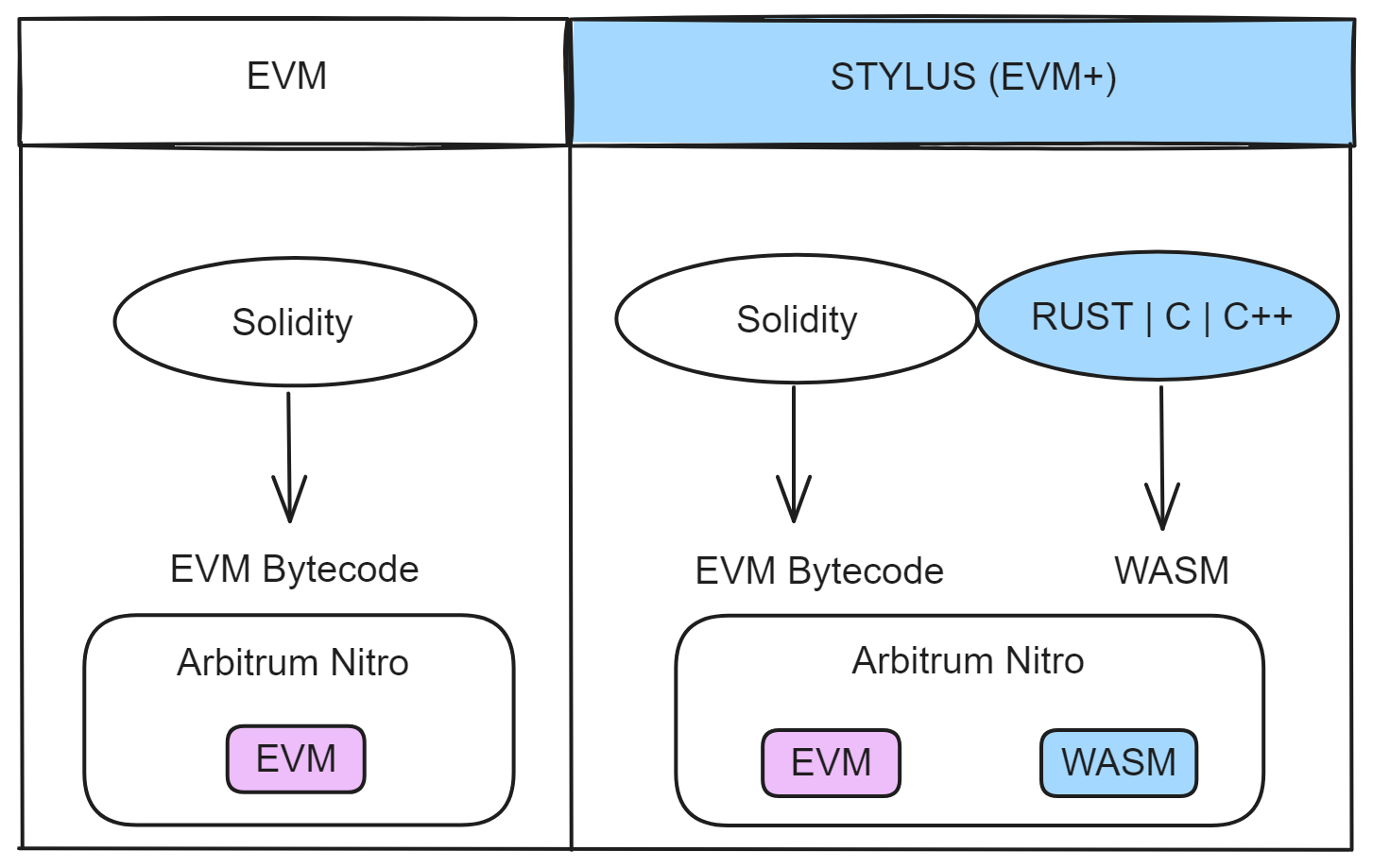
- Developers write smart contracts using programming languages supported by Stylus, such as C, C++, or Rust.
- The contract code is compiled off-chain using a standard WASM compiler for the chosen languages.
- The resulting WASM bytecode is posted onto Arbitrum in compressed form.
- Stylus contracts are executed using Wasmer, a WASM runtime.
- The Stylus proving model extends Nitro’s fraud prover, “Arbitrator”.
Due to the superior efficiency of WASM programs, Stylus contracts are magnitudes faster with significantly lower gas fees. This is a unique advantage that Stylus offers over other stacks.
In a standard EVM, when the hardware receives data, it must check that it is accurate, enable branches, and simulate it in memory — steps that often take a great deal of time. In contrast, Stylus is designed to speak the language of the central processing unit (CPU), making it possible to circumvent that extra layer of interpretation and speed up compute workloads.
In fact, Stylus is only possible because of Nitro’s unique fraud-proving technology. When there is a dispute on Arbitrum, Nitro replays the execution to solve this dispute in WASM. Hence, since Nitro can deterministically prove arbitrary WASM code, it also means that it can prove the correctness of any program that compiles down to WASM.
Table: WASM vs. EVM

As an example, we can compare the efficiency of the WASM runtime with the current state of the EVM. For instance, a simple ADD operation is 150x cheaper to execute on WASM than on the EVM. When extrapolated to other compute-intensive tasks, Stylus might even cut costs somewhere between 10, 50, or 100x.
Image: Gas Required for Add Operations on EVM vs. WASM

While Ethereum’s real-time quadratic cost calculation makes memory expansion progressively more expensive, Stylus offers a 100x-500x cheaper memory allocation compared to Ethereum’s quadratic memory expansion cost.
Table: Cost of Memory on EVM vs. Stylus

With Stylus, the EVM is no longer the ceiling, it’s the floor. Furthermore, Styles and Solidity contracts are composable and fully interoperable. In Solidity, you can call a Rust program and vice versa. This way, developers get the benefits of popular programming languages without changing how the EVM works.
Image: Benefits of Stylus

Advanced use cases that aren’t practical on the EVM are now possible in Stylus. What’s more, Stylus is not only more efficient but also safer. For instance, developers can rely on reentrancy protections out of the box, mitigating one of the most common attack vectors in Solidity.
Learn more about Arbitrum Stylus in Alea Research’s: Breakdown!
Arbitrum Orbits
With Arbitrum consolidating as the most adopted L2, the next step is to attract more projects to build on top of its tech stack. While Arbitrum has been the most dominant L2, it has lagged with regard to the adoption of its tech stack. This is especially true compared to Optimism’s Bedrock stack which has seen wider adoption by players such as Base, Binance, and other prominent names.
Arbitrum aims to fill this gap with Orbits. Orbits allow for the permissionless deployment of Orbit chains. These are L3s that settle onto Arbitrum Nova or Arbitrum One, or L2s that settle on Ethereum. One of their strengths is their customizability; Arbitrum has even gone as far as branding this solution as “tailored chains”. Orbit chains can be conceptualized as configurable instances of the Arbitrum Nitro tech stack, tailored to specific use cases and business needs.
Image: Settlement for L2 and L3 Orbit chains

Beyond leveraging the network effects of a thriving ecosystem like Arbitrum, Orbit chains enable full ownership and customization capabilities. This involves privacy settings, permissions, governance, fee tokens, and more.
Table: Advantages of Orbit Chains

Orbit chains benefit from all tech upgrades performed on Arbitrum Nitro. For example, they can embrace the release of Arbitrum Stylus, allowing developers to deploy EVM-compatible applications harnessing the power of programming languages such as C, C++, Rust, Solidity, and Vyper.
One feature that makes Orbit chains special is “elastic block time”. This makes it possible to produce blocks based on demand, allowing the chain to save extra costs during periods of inactivity and improve UX during periods of high demand for block space. For instance, during periods of high activity, they can produce as many as four blocks per second. Similarly, during periods of inactivity, the chain would stop producing blocks – avoiding paying Ethereum settlement costs with empty blocks.
With the upcoming release of interoperability features and integration with Celestia for Data Availability, we expect more projects to want to build their appchains on top of an already established and thriving ecosystem like Arbitrum.
Additionally, Rollups as a Service (RaaS) providers like Caldera, Conduit, and Altlayer have already extended support for Orbit chain deployments. These providers can facilitate services from rollup management to no-code deployment solutions, simplifying the technical intricacies of building and managing DevOps and Rollups infrastructure.
There are currently 50+ projects confirmed to be launching as an Orbit chain, including names such as Xai Games, Deri Protocol, Hook Protocol, Sanko Game Corp, Polychain Monsters, and more.
Image: The Ecosystem of Orbit Chains

Finally, it is also worth noting that one of the most notable aspects of L3s on Arbitrum is the fee payment to the Arbitrum sequencer. This improves the economic model, establishing a sustainable value accrual mechanism for the Arbitrum DAO. By transforming Arbitrum into a settlement layer akin to Ethereum, we can expect more value to be added to the core chain, bolstering the long-term scalability of the ecosystem.
Learn more about Orbits in Alea Research’s Breakdown Arbitrum!
Chain Clusters
In January 2024, Co-Founder and Chief Scientist of Arbitrum, Ed Felten announced a new initiative being developed in the Arbitrum Forum called Chain Cluster. Chain Clusters refer to a set of L2 and L3 chains that can seamlessly communicate with each other. This way, cross-chain asset transfers could be achieved even faster than the settlement times of individual chains.
Imagine a “chain cluster” as a group of interconnected chains. These chains can talk to each other much faster than they could on their own. Chains as part of this cluster can even swap assets between them. This vision can be realized in two different ways. While technically backed by the same considerations, each enables specific use cases.
Image: Single Chain Expansion vs. Independent Chains

Single Chain Expansion: a single chain might want to take a sharding approach – expanding its capabilities with a set of clustered chains that have identical code and configuration, and are governed in the same way as the original chain.
Independent Chains: a series of separately governed chains might want to reach an agreement for being part of the same cluster to reach much faster cross-chain interactions.
Even though specific details about the implementation have not been shared yet, the main idea is this: If Chain A and Chain B are in the same cluster, a node in Chain B must trust Chain A’s information.
Image: Chains in the Same Cluster Must Trust Each Other’s Information

The most straightforward way is for the same party to operate nodes for both chains. So, if you run a B-node, you also run an A-node. Hence, even if each chain has its own independent governance structure, it must still agree on a series of joint principles to define the cluster.
Note that joining a cluster cannot be a permissionless process, since every chain in the cluster is obligated to run a node for the newly joined chain. Furthermore, to realize this vision, a common language for settling transactions is needed – even if each chain relies on its own proof system.
This implies the need for a single framework that spans all chains in the cluster. The reason this is essential is that events on one chain quickly affect others. Hence, proving will need to be a coordinated process and joint endeavor across all chains in the cluster.
On the security front, it’s important to note that if one chain in the cluster finds a problem, it affects all chains in the cluster. For example, if Chain A stops, other chains in the cluster can’t move forward. For that reason, there is a need for a joint governance structure or policy that regulates and approves any upgrades or security-critical configuration changes.
Competitive Landscape
The Arbitrum ecosystem is a hub of innovation and development, hosting an extensive range of protocols that not only provide users with a rich playground of options but also contribute to strong network effects.
Arbitrum is home to a thriving ecosystem with over 531 protocols building on it, making it the 3rd most active blockchain, only after BSC and Ethereum. For reference, other L2s such as Optimism and Base host 200+ protocols, placing 7th and 8th respectively.
L2s come in all shapes and sizes and can be categorized primarily by their type, stage, and base technology (as defined by L2beat). Each comes with its trade-offs in security, speed, EVM equivalence, transaction costs, and more.
For reference, a rollup is an execution layer that relies on a base chain for settlement and data availability, whereas an Optimium or a Validium uses a separate DA solution. These solutions can also differ in their state validation proving mechanism: Optimistic rollups use fraud-proofs (EVM equivalent) whereas ZK rollups use ZK (validity) proofs.
And, any of the above configurations can be built in different ways at the codebase level.
Table: L2s in Order of TVL

The launch of Arbitrum’s native token, $ARB, marked a pivotal moment for the protocol. While it was speculated that activity on Arbitrum would plummet after the airdrop, with farmers moving to new blockchain networks to pillage, the network has shown its resilience and attractiveness towards crypto users.
Notably, the robustness of key metrics post-airdrop such as the increase in daily transactions, signifies sustained utilization and engagement within the ecosystem, transcending the initial excitement of the airdrop event.
Regarding developer adoption, the ease of replicating code and building on top of a tech stack is a significant competitive factor amongst L2s. Arbitrum’s tech-based offerings and strong performance metrics have given it a sharp competitive edge in attracting developers and projects.
Arbitrum also leads in its efforts to remove the “training wheels” from L2 solutions as it’s governed by smart contracts and is the only optimistic rollup to have fraud proofs in place, although they are currently only in place for 14 whitelisted actors. With these validators in place, the execution of any fraudulent transaction is mitigated if at least one of them acts honestly.
In optimistic rollups, the main trust assumption comes from upgradeability. In the case of Arbitrum, this is controlled by the DAO with a 3-day delay, or instantaneously by a 9/12 community-elected multisig. Still, reliance on a centralized sequencer poses risks in terms of downtime. However, on Arbitrum, if the sequencer goes down, funds in the bridge are recoverable after 7 days.
The Arbitrum Ecosystem
Arbitrum’s influence in DeFi is substantial, particularly in derivatives. Current data points towards Arbitrum as the preferred L2 for protocols to deploy on and attract the largest number of users. The core strengths of the ecosystem are its community, product innovation, and targeted user engagement campaigns. Together they contribute towards an expanding ecosystem of dApps.
We have seen how projects in Arbitrum tend to work together instead of against each other. This spurred great product composability in the ecosystem, with projects working to make the whole pie bigger for everyone rather than fighting for one slice. Arbitrum’s thriving ecosystem has strong network effects that contribute when protocols are deciding which chain to deploy upon.
The most notable example of collaborative effort on Arbitrum can be found in the token $GLP, the liquidity pool token of GMX v1 – a basket of assets acting as the counterparty to traders. $GLP earned massive fees from traders as well as being their counterparty, driving APRs frequently over 30%; rewards in pure $ETH.
As a result, we saw a multitude of product-building GLP-based vaults and protocols such as Umami Finance, Jones DAO, and GMD Protocol. On the trading side, GMX was used by options protocols, i.e., Lyra and Rysk, to hedge their delta, while aggregators, i.e., MUX and Rage Trade, built new frontends and routing to support the deep liquidity DEX.
This spirit of collaboration can be seen almost anywhere you look within Arbitrum, usually driven by native protocols on the chain. Another example is Camelot’s support for protocol launches on Arbitrum, helping them to achieve protocol-owned liquidity (POL) through Camelot’s launchpad. Even money markets bought into the ethos, with projects such as Silo and Dolomite supporting native yield-bearing assets.
All things considered, Arbitrum has become a massive pillar in the Ethereum ecosystem as the leading L2 and much of it can be attributed to the positive sum attitude of builders, attempting to grow the pie together rather than compete for a small slice. This approach has been embodied in the Arbitrum DAO itself, with builders, researchers, analysts, and Arbitrum-native service providers all coming together to drive the ecosystem forward collectively.
The Arbitrum DAO
The Arbitrum DAO was created with the launch of the $ARB token in 2023. The DAO serves as the governing body responsible for overseeing both the organization and the technologies of the Arbitrum stack.
Deployed on the Arbitrum One rollup chain, the governance smart contracts manage upgrades to the Arbitrum chain as well as the DAO’s treasury, which is allocated for fueling growth initiatives within Arbitrum. To backstop the DAO, an elected Security Council is in place to address critical risks to Arbitrum that could outpace standard governance operations.
The DAO has been fairly busy since its inception. While slow and reluctant to act at first, in fear of a lack of frameworks and processes, the DAO has grown into its role as the owner of Arbitrum’s strategy and operations.
After it became evident that structural and operational guidance would not come from the Arbitrum Foundation and/or Offchain Labs, the DAO and its practices have improved over time. While there’s always much to improve, groups across the DAO are contemplating strategic goals, creating various initiatives, and iterating with tight feedback loops.
The most notable event originated by the DAO was, of course, the Short-term Incentive Program (STIP), a strategic initiative that aimed to bolster network activity and increase user retention within the Arbitrum ecosystem and its subsequent Backfund.
STIP – Short-Term Incentive Program
By allocating up to 50M $ARB across 30 projects, the key objective was to grow activity on the chain, increase the overall user base, solidify, battletest, bootstrap products, and increase sequencer fees.
As the program is still running, a complete analysis of its performance is not yet complete. In the initial STIP, perpetual-based protocols emerged as predominant beneficiaries, receiving 44% of the total grant. DEXs secured the second largest share, with 15% of the total allocation. GMX stood out as the top grantee, receiving a total allocation of 12M $ARB tokens.
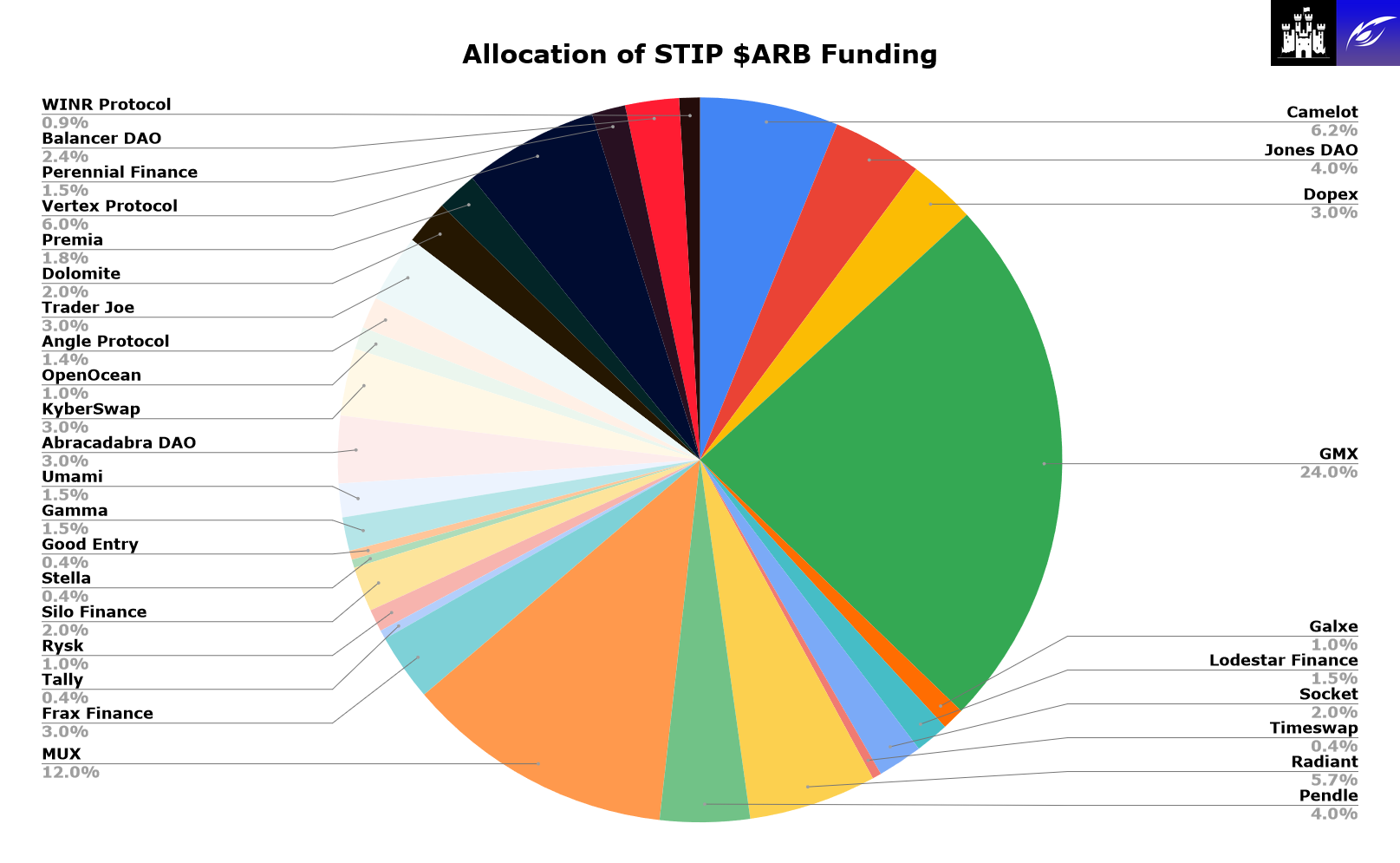 |
Source: Arbitrum Forum (STIP Grant Recipients)
Following the initial grant distribution, the Arbitrum DAO approved a one-time 21.4M $ARB backfund to reward 26 projects that were overlooked in the first round. These projects, while securing enough votes, exceeded the original budgeted 50M $ARB.
This time, another perp, Gains Network, took the biggest share of the pie, with 4.5M $ARB. Also notable in this second allocation is the large presence of bridging protocols, such as Stargate, Synapse, and Wormhole.
The backfund itself was a contentious grant, mainly because delegates would have voted differently had they known the DAO had more capital to allocate. Some delegates were likely capping their votes at 50M, while others were not. Additionally, having just gone through the massive task of reviewing 100+ STIP applications and voting for each one individually, discussion and voter fatigue had likely kicked in by the time the backfund proposal went live.
While the STIP and backfund have yet to draw to a complete close, the DAO hasn’t stopped moving. In fact, a new program, the Long-term Incentive Program Pilot (LTIPP) is about to kick off applying learnings from the STIP. The LTIPP is a short 3-month incentive program with new application processes, new frameworks and rubrics, new roles, and more.
LTIPP – Long-Term Incentive Program Pilot
The pilot program can distribute up to 45M ARB to protocols to incentivize users on their products. The scope of the pilot is to incorporate learnings from the STIP to establish a better framework for future incentive programs – some of the barriers to be overcome are:
- The short timeframe of the application window
- The amount of weight put on delegates, who were expected to vote on every application (100+ Snapshot votes)
- The lack of a framework through which applications are assessed
- The lack of a formalized feedback process meant teams were left in the dark
For these reasons, the LTIPP introduces two new roles: the Council Member and the Advisor. In total, there will be 5 Council Members and 3 Advisors.
- Both the Council members and the Advisors will be responsible for creating a rubric that all protocols will be judged against as well as crafting an application template and process for all protocols.
- Council members will decide who progresses to the Snapshot vote.
- Advisors will help protocols design, implement, and update their incentive plans.
The Council Members and Advisors have been elected by $ARB holders, reflecting their previous contributions to the ecosystem. The approach chosen in the LTIPP aims to establish more structured entities with specialized knowledge and experience.
However, this comes with its own trade-offs. On one hand, the process can benefit from the efficiency of a concentrated decision-maker in the Council with specialist support from knowledgeable and experienced Advisors. On the other, this results in the concentration of power as opposed to more decentralized forms of community feedback.
Nonetheless, it must be pointed out that there are several checks and balances to ensure that Council Members and Advisors are held accountable for their work. It must also be taken into account that this is indeed a pilot. As such, we can expect an iterative process that will continually bring improvement for future incentive programs. Testing different approaches allows the Arbitrum DAO to gather data on their effectiveness and adjust accordingly.
The chosen solution seems to strike a balance between efficiency and decentralization, providing additional support and accountability of projects through Advisors, and ensuring a common framework to evaluate projects through the Council.
Here’s a snippet of the application process for the LTIPP:
- Projects have 2 weeks to apply
- Post-application, there will be 2 weeks in which projects receive feedback from Advisors. Advisors will hold office hours to have discussions with projects, ensuring enough time for projects to adjust proposals accordingly.
- The Council will then select grant recipients, subject to a Snapshot vote by Arbitrum delegates.
These measures ensure a more guided approach compared to the STIP and will hopefully improve the efficiency of incentive programs and their second-order impact on the Arbitrum ecosystem.
If you are looking to apply check out the original forum proposal.
Fees and DAO Revenue
A portion of gas fees paid by Arbitrum One and Arbitrum Nova users are sent to the Arbitrum DAO. On Arbitrum, fees are two-dimensional: the first is the fee that covers computational costs on L2 and the second is the fee that covers costs to post on L1.
The L1 Base Fee which includes the cost of posting data on mainnet L1 through calldata is accrued in its entirety by the Sequencer. The DAO then receives 80% of the fees collected from the L2 Base Fee, which is the fee users pay when transacting on L2.
Through these fees, the Arbitrum DAO has accumulated nearly 14,000 ETH in net revenue, averaging over 700 $ETH per month. Some interesting strategies and uses of this revenue have been:
- Retroactive public goods funding
- Other grant programs to reduce dependence on ARB
- Increase on-chain DAO-owned liquidity and decrease reliance on CEXes (75% of trading volume)
- Stake the ETH with key partner LST protocols
- Explore collaboration opportunities
- Drive initiatives for sequencer decentralization
Key Metrics
Arbitrum’s sustainable cash flow is fueled by gas consumption and transaction activities from ecosystem projects. In 2023, the treasury benefited from sequencer profits of ~$16.6M, earmarked for future growth initiatives.
Token Price
After years of development and nearly 18 months running on mainnet, the Arbitrum token ($ARB) airdrop took place in March 2023, distributing 1.16 billion $ARB to 625,000 users within the Arbitrum ecosystem.
After the airdrop, the price of $ARB showed relative stability, hovering around the $1 mark and fluctuating within approximately 10% to 20% of this level for most of the year, although it did reach an all-time low of $0.74 in September 2023.
Then, as the crypto market rallied in December 2023 due to the anticipation of a potential spot $BTC ETF approval, $ARB’s price surged along with the broader market, eventually reaching an all-time high of $2.4 in January 2024.
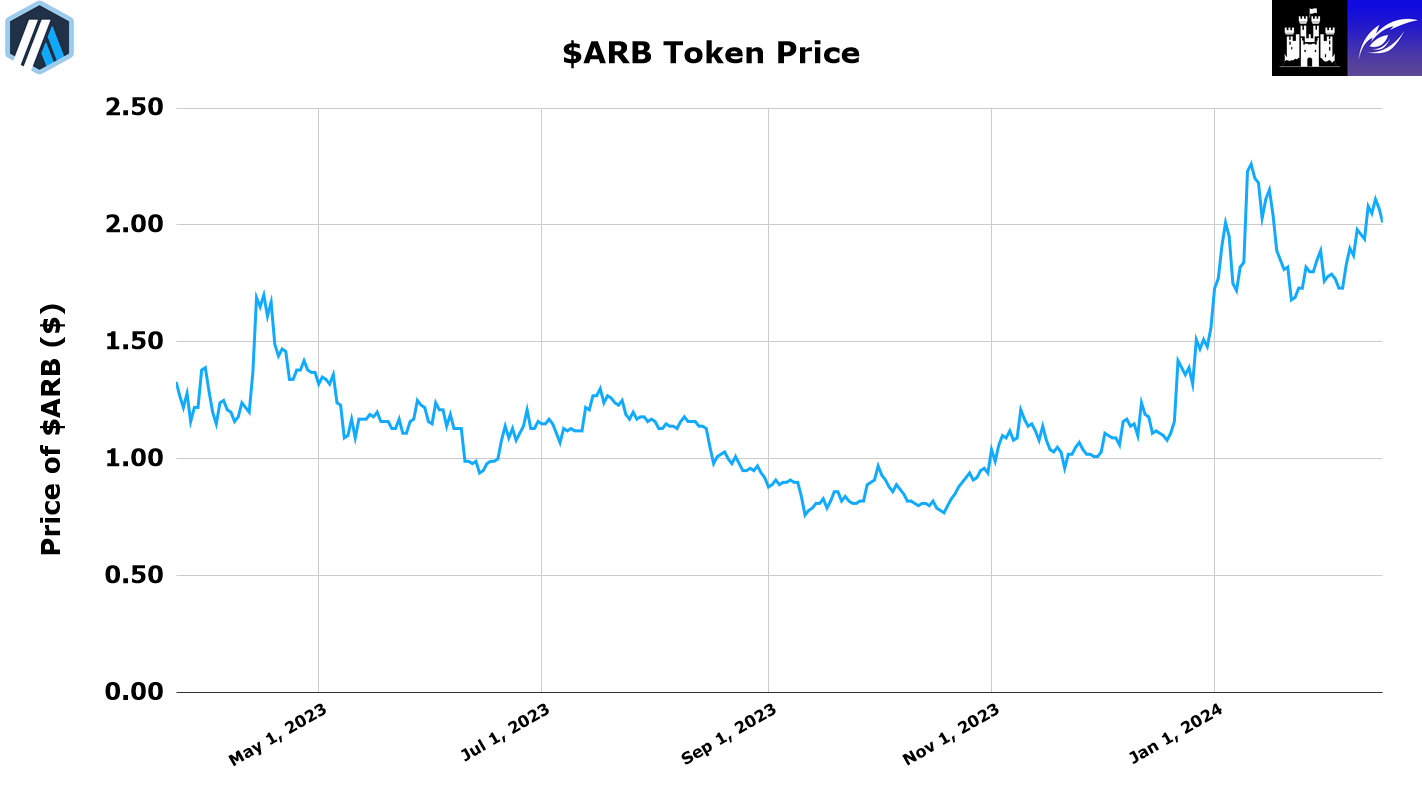 |
Source: Token Terminal
Upcoming Unlocks
Arbitrum has a token unlock scheduled for March 16, 2024, when 1.11 billion $ARB tokens—valued at approximately $2.15 billion (ARB is $1.94 at the time of this writing)—will be released into circulation. Currently, the market capitalization of $ARB stands at approximately $2.47 billion, with the circulating supply of 1.275 billion $ARB tokens representing 12.75% of the maximum supply (10 billion tokens).
This event will notably introduce 87% of the token’s current circulating supply into the market, marking the commencement of four years of staggered releases aimed at enhancing liquidity. Specifically, 673.50 million $ARB tokens allocated to the team, future team, and advisors, along with 438.25 million $ARB tokens for investors, will significantly increase the circulating supply on the market.
The Arbitrum DAO Treasury was fully unlocked at token launch, making this the first token unlock for the Team, Advisors, and Investors. Following this initial release, Arbitrum will proceed with linear releases every four weeks for the next four years, continuing until March 2028. While token unlocks typically introduce potential selling pressure due to the increased market supply, they also enhance liquidity and not all recipients will become sellers.
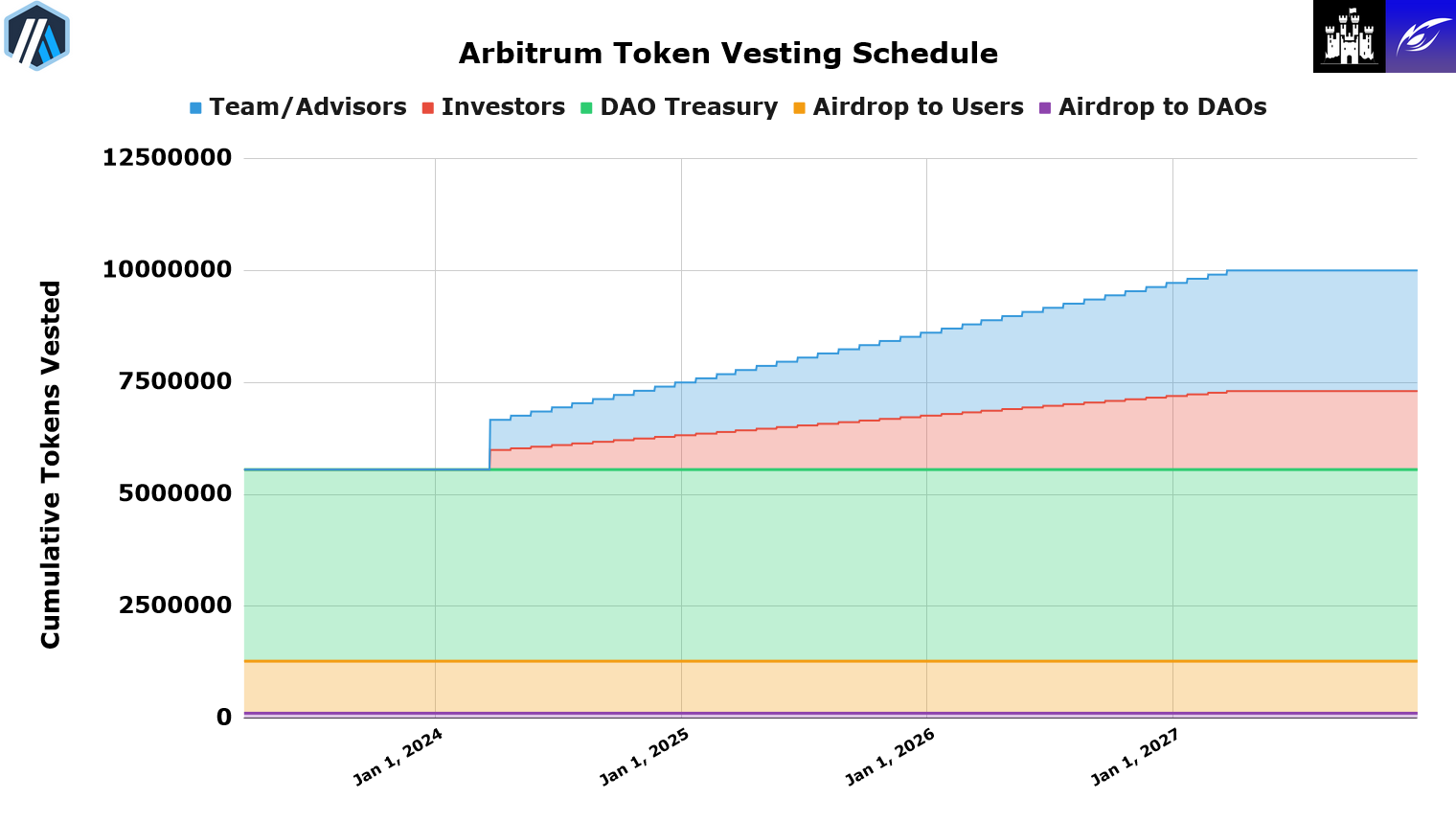 |
Source: Token Terminal
TVL
Arbitrum has firmly established itself as a leading L2 solution, commanding an impressive 50% of the L2 market share. With a TVL of approximately $3 billion, it stands as the fourth largest blockchain network, surpassed only by Ethereum, Tron, and the BNB Chain. This position is particularly remarkable considering Arbitrum’s TVL outpaces Solana by $1 billion, a network that has enjoyed considerable attention in the past year due to $SOL price surges, meme coin popularity, and strategic airdrops.
In the L2 landscape, Optimism stands out as the second-largest by TVL, commanding about $1 billion, which translates to approximately 26% of the L2 market share. Manta Pacific is the third largest L2 based on TVL, boasting a TVL of $528 million, closely followed by Coinbase’s L2, Base, which has attracted $387 million in TVL. Despite these platforms launching various campaigns and hosting intriguing dApps, they have yet to replicate the vibrant and diverse ecosystem that Arbitrum has cultivated.
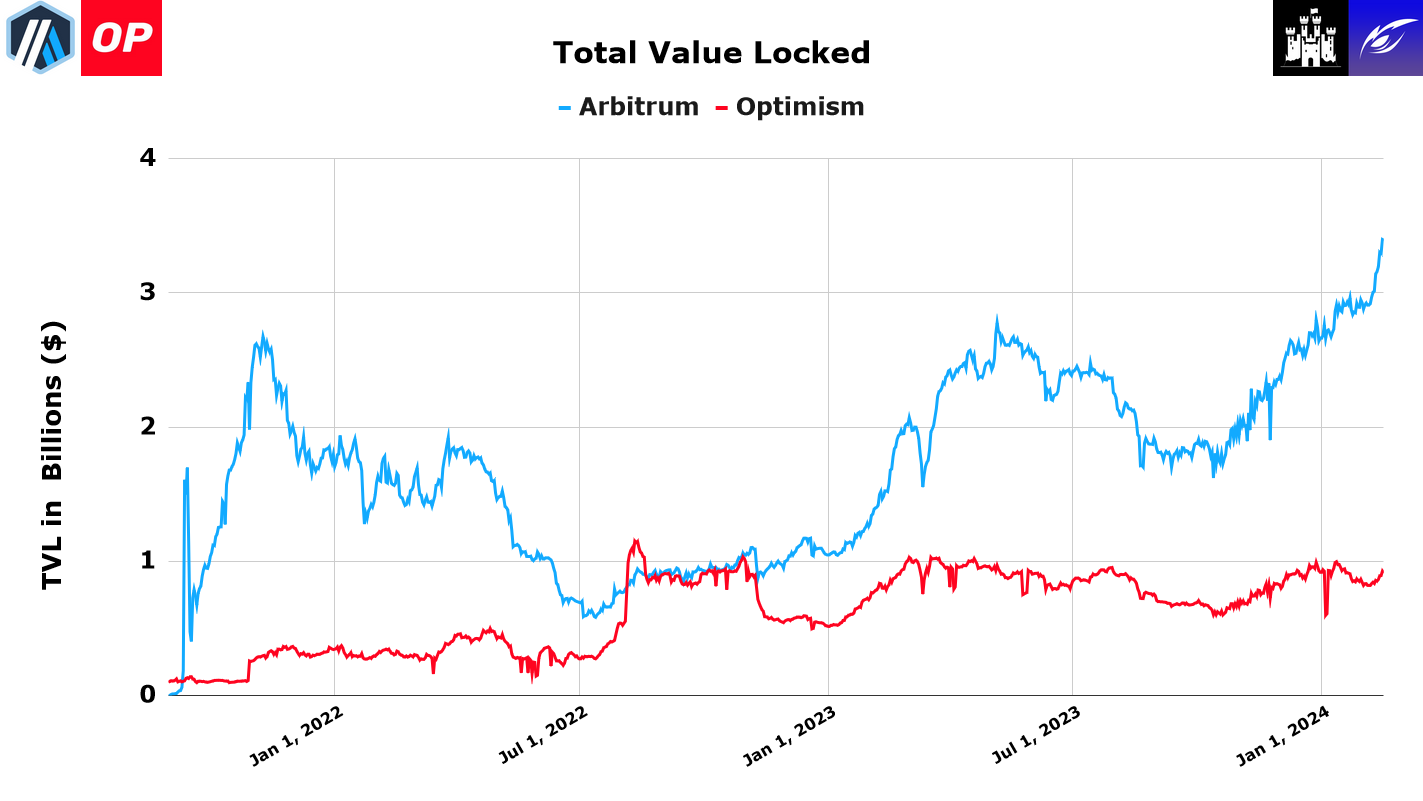 |
Source: DeFiLlama
At the heart of Arbitrum’s success is its robust ecosystem of decentralized applications, with GMX leading at a TVL of $555 million, followed by Aave with $360 million, Pendle with $260 million, and Hyperliquid with $170 million. Aave’s substantial TVL on Arbitrum, compared to its $130 million on Optimism, highlights the chain’s efficiency and appeal for leveraging borrowing markets.
The comparison of Pendle’s TVL, closely matching that of Synthetix at $265 million, further illustrates the competitive and thriving dApp landscape on Arbitrum. This parity not only underscores the robustness of Arbitrum’s ecosystem but also signifies that the third-largest and rapidly growing dApp on Arbitrum has already matched the highest TVL dApp on Optimism, showcasing the network’s growth and appeal.
The recent surge in Arbitrum’s TVL can be attributed to the significant contributions from Pendle and Hyperliquid. Pendle’s TVL experienced a remarkable increase, soaring from $100 million in early January 2024 to over $250 million by mid-February 2024, following its launch on Arbitrum in early 2023.
Pendle’s growth is largely due to the Liquid Restaked Token (LRT) pools on Arbitrum, which have drawn users to deposit and farm Kelp, Ether.fi, and Eigenlayer points with enhanced multipliers.
Hyperliquid, on the other hand, has carved out a niche for decentralized trading, appealing to users with its competitive spreads for low market cap meme coins and the promise of Hyperliquid points, anticipating future airdrops. These developments are indicators of a thriving ecosystem, driven by innovative platforms and user incentives that bolster Arbitrum’s position in the DeFi space.
Active Addresses
Comparing Arbitrum to OP mainnet, which serves as the ideal benchmark given the competitive proximity, when it comes to operational metrics they started very close to each other. However, as time passed, the gap widened in favor of Arbitrum.
In 2023, Arbitrum averaged almost 150,000 daily active addresses, significantly more than Optimism’s ~71,000.
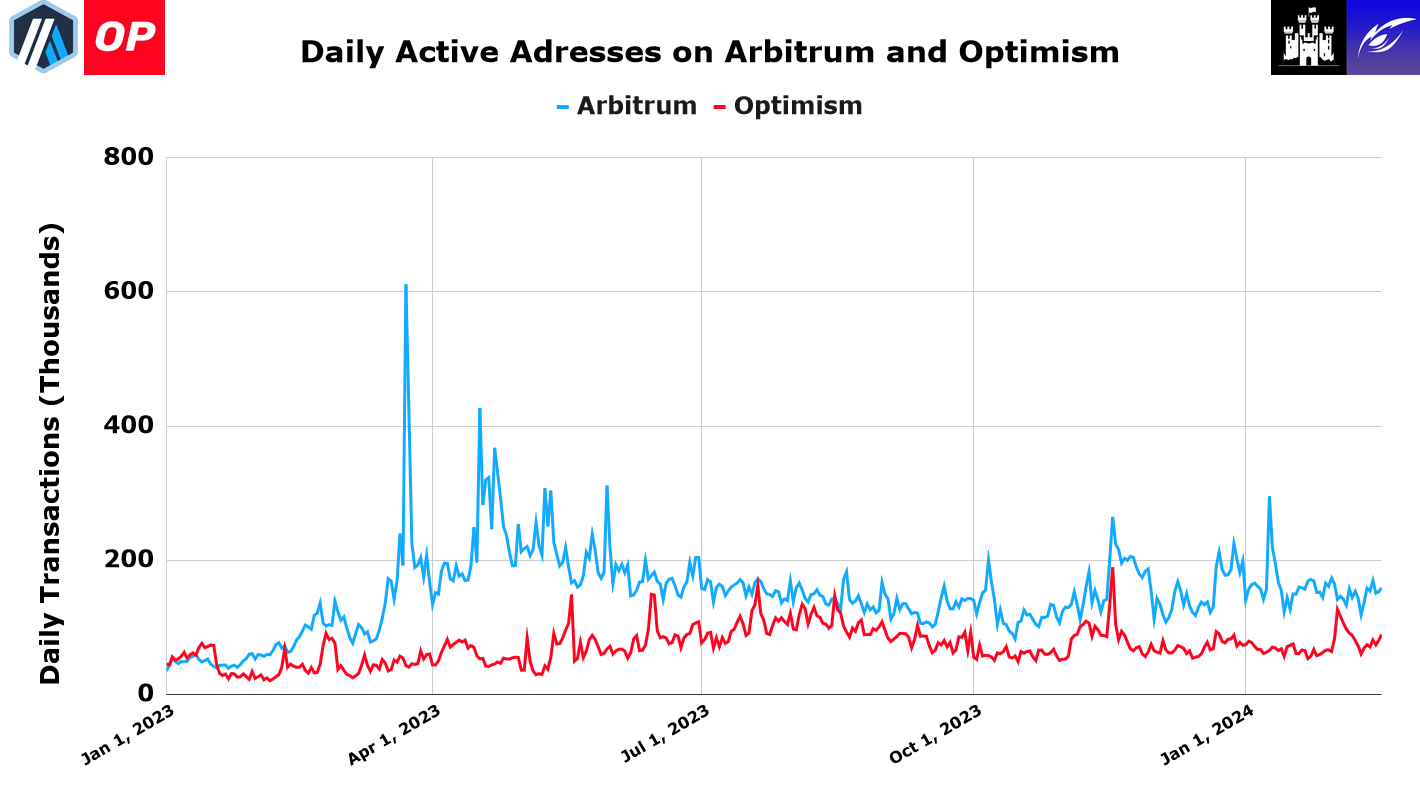 |
Source: Token Terminal
Daily Transactions
Besides the dominance in daily active users, Arbitrum also recorded a higher number of transactions. Averaging over 1M daily transactions, this represents more than double that of its closest competitor, Optimism, which has a daily average of 400,000 transactions.
Nevertheless, it’s worth noting that December data might not be statistically significant due to the peak figures being achieved due to an inscriptions frenzy that extended to multiple EVM-compatible chains. Regardless, Arbitrum is one of the few chains that has managed to record days surpassing the transaction counts of Ethereum.
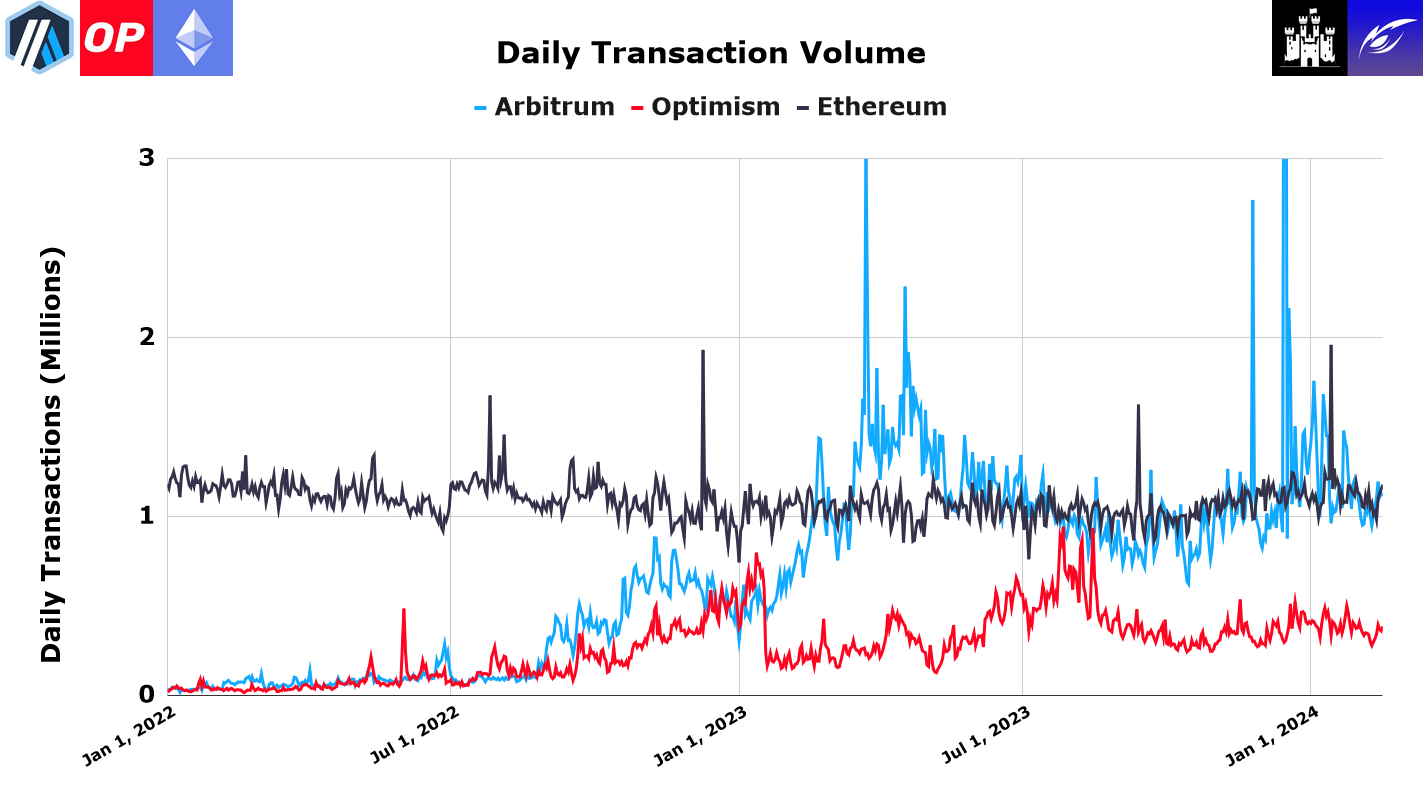 |
Source: Token Terminal
Valuation data
Below we compare Arbitrum to other L2s like Optimism and Manta, using data from Token Terminal. Note that other L2s like Base, and zkSync Era aren’t included because their tokens either aren’t live or their data is not yet provided by Token Terminal.

Arbitrum dominates its competitors with a P/F Ratio (Fully Diluted) of 230.95, underlining its ability to generate substantial fees relative to its market cap. This ratio points to Arbitrum’s operational efficiency and strong growth trajectory.
In comparison, Optimism’s P/F Ratio of 250.60, while showing solid fee generation, suggests a slower alignment of fees with market cap. Manta Pacific, with a P/F Ratio of 165.72, shows a keen strategy for monetization, though its recent fee and revenue uptick can be attributed to an aggressive airdrop campaign. As this campaign has concluded, it remains to be seen if Manta Pacific can sustain these heightened levels of fee generation.
Arbitrum’s P/F Ratio (Circulating) of 29.45 paints it as significantly undervalued when actual market activity is considered, signaling a potential oversight in its operational valuation. Manta Pacific’s 39.82 and Optimism’s 37.61 ratios, though not as low, still offer attractive value, reflecting well on their market confidence and perception around fee generation.
With P/S Ratios of 230.95 (Fully Diluted) and 29.45 (Circulating), Arbitrum demonstrates a compelling case as an underrecognized leader in revenue efficiency, standing well above its competitors. Manta Pacific follows suit with a respectable P/S Ratio of 165.72. However, it will need to demonstrate that the increase in fees and revenues is sustainable post-airdrop to validate its current valuation. Optimism’s P/S Ratio of 250.60 indicates it has room to grow in revenue efficiency.
Arbitrum’s metrics not only highlight its current fiscal prudence but also its potential for continued ascendance in the L2 sector.
Closing Thoughts
Current State of Arbitrum
- Market Dominance: Arbitrum has established itself as a leading force in the Ethereum L2 ecosystem. It commands a significant market share, evidenced by its dominance with approximately half of the market share in this space.
- Protocol Adoption: With over 500 protocols deployed, Arbitrum demonstrates mass adoption and utility.
- Focus on DeFi and Derivatives: Arbitrum has become a hub for DeFi and derivative projects, indicating a strong market position in these sectors.
- DAO Revenue and Initiatives: The Arbitrum DAO has been successful in generating substantial revenue, primarily from sequencer profits. Initiatives like STIP and LTIP reflect a strategic focus on ecosystem growth.
Future Prospects
- Technological Developments: The Dencun upgrade and EIP-4844 are poised to significantly enhance Arbitrum’s economic model by reducing costs by almost 90%. This improvement is crucial for maintaining competitiveness and attracting more users and developers.
- Strategic Upgrades: The introduction of Arbitrum Stylus and the launch of new Arbitrum Orbits are anticipated to provide enhancements, further solidifying its strategic advantage in the market.
- Market Expansion: The platform’s continued innovation and upgrades, coupled with its strong current market position, suggest a trajectory of growth and expansion in DeFi.
- Ecosystem Growth: The $ARB airdrop and the focus on community-driven initiatives indicate a commitment to fostering a strong and engaged user base, which is important for long-term success.
Arbitrum stands out as a dominant player in the Ethereum L2 ecosystem. Its current market position, strategic technological upgrades, and a focus on community and ecosystem development position it well for sustained growth and influence in the DeFi space. The future of Arbitrum is promising, with the potential for increased adoption, technological advancements, and a significant role in shaping the landscape of decentralized finance.
References
- Alea Research Arbitrum Breakdown
- Castle Capital Deep Dive into Data Availability
- Arbitrum Stylus
- Quickstart guide – Launch an Orbit Chain
- Arbitrum Research Forum
- STIP – Arbitrum Proposal
- STIP Grant Recipients
- Backfund Successful STIP Proposals
Data sources
Disclosures
Alea Research and Castle Capital have never had a commercial relationship with the Arbitrum DAO or Offchain Labs and this report was not paid for or commissioned in any way.
Members of the Alea Research and Castle Capital teams, including those directly involved in the analysis above, may have positions in the tokens discussed.
This content is provided for educational purposes only and does not constitute financial or investment advice. You should do your own research and only invest what you can afford to lose. Alea Research and Castle Capital are research platforms and are not investment or financial advisors.
A Alea Research and Castle Capital Collaboration
Support Alea Research and Castle Capital by following their socials, sharing their work, and subscribing to their newsletters!




